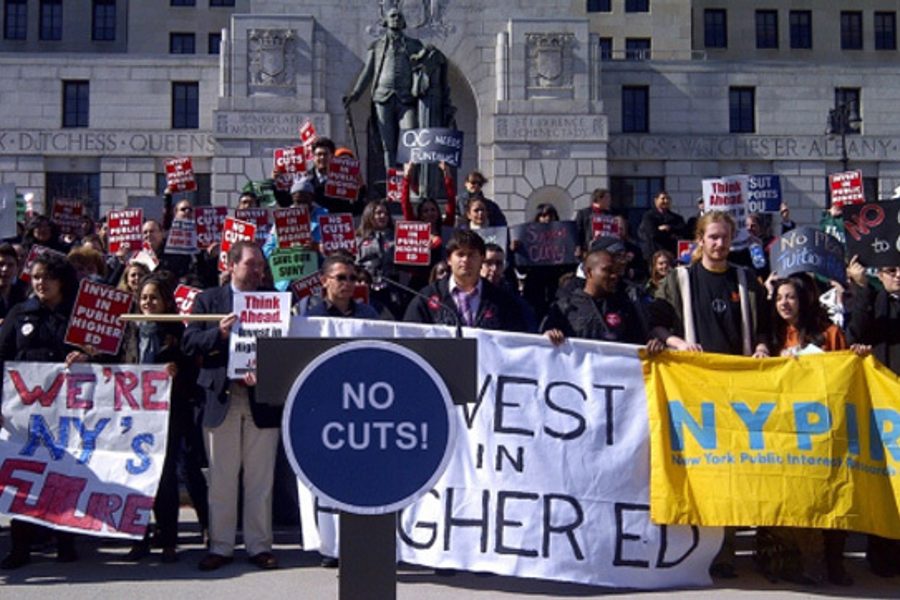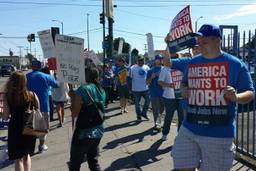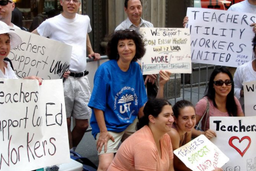Save Our Schools
Student organizers with Save Our SUNY are fighting austerities—new and old—in New York state’s higher ed system.
James Cersonsky

With 64 colleges and universities in the State University of New York (SUNY) system, and 23 colleges and institutions connected to the City University of New York (CUNY), New York has the most expansive public higher education system in the country. It also has one of the least affordable tuition rates. Under brand-new legislation, students – who are now organizing to fight the increasingly neoliberal tilt of university systems – can expect to pay more for years to come.
On August 9, Governor Andrew Cuomo (D) signed the NYSUNY 2020 Challenge Grant Program Act, which calls for $140 million in new capital funding while raising tuition rates sharply for students across the state. All SUNY and CUNY students will see a 5.4 percent yearly hike for the next five years, with additional increases at SUNY’s four University Centers around the state.
Cuomo and elected officials from both parties have heralded the flat yearly hike as a “rational tuition” plan. It replaces the erratic spikes that students have come to expect from state legislators. But in a state whose net tuition already ranks among the highest proportionate to family income – earning it an “F” in affordability from the National Center for Public Policy and Higher Education – any tuition increase is of relative “rationality.” Score one for state leaders trying to make ends meet without causing an uproar; condolences to students and families already under the bus.
In the wake of our most recent financial crisis, universities have intensified their commitment to the same neoliberal restructuring – downsizing, privatization, and centralization of control – that strangles the public sector nationwide. Administrators and trustees campaign for greater investment in high-end scientific research – and higher salaries – often by way of shifting academic planning from faculty and departmental heads to themselves. Graduate and nontenured faculty in the humanities and social sciences, whose output is less profitable, endure research speed-up, pay cuts and a thinning market for family-sustaining jobs. And undergraduate students, whom governments are increasingly less willing to subsidize, are forced to pursue more lucrative credentials, in greater quantities and at higher cost.
We’ve come a long way since New York’s state fiscal crisis of 1975-76, when business and Wall Street consolidated their efforts to slash government spending. It was then that CUNY first started charging tuition. Now American higher ed is a wellspring of marketable research and, in turn, an outlet for global financial investment. The ironies of globalization are ripe for harvest. SUNY may put the “world within reach,” as its tagline reads, but that means cutting less lucrative foreign language departments and upping its recruitment of international students who can pump precious out-of-state tuition dollars into the system.
Enter Save Our SUNY (S.O.S.), a statewide campaign to build student power and reverse the course of higher ed policy. In recent months, students have stormed the state capitol to combat Cuomo’s regressive tuition plan and protest poverty wages for grad student teaching.
On the eve of Cuomo’s signing, I got to chat with four students from S.O.S.’s SUNY-Albany team. Sean Collins is a rising senior studying political science. James Searle is a Ph.D. student in the Department of English. Jackie Hayes and Rafael Gomez both hold multiple degrees from SUNY or CUNY schools and are now pursuing Ph.Ds in Latin American and Caribbean Studies. A condensed version of our conversation follows.
So, why all the protests?
James: The basic problem we’re dealing with is that students as a class are fundamentally unrepresented. What Cuomo’s really doing is taxing students using tuition dollars. Fundamentally, we’re about access, affordable quality education, and more primarily, student empowerment. In a kind of ironic way, the budget places students alongside other under-represented or ignored parties that they traditionally don’t mix with. So, we’re excited about the opportunity to work with community organizers, labor folks, and K-12 people in the hope of building a collective movement.
So this is not just a student movement.
Jackie: That’s right. We started organizing last summer around this thing called the Public Higher Education Empowerment and Innovation Act. That act included tuition indexing, differential tuition, more flexibility for the university to sell off public lands, more privatizing in certain areas of the university. Then we had university budget cuts, and the University of Albany lost five departments. That’s when we started organizing a little more and got in touch with New York Communities for Change, Alliance for Quality Education; we talked and worked with UUP [United University Professions, the academic and professional employees union], the graduate student union, Vocal NY, Citizen Action.
We’re slowly building a stronger connection with a lot of other public areas that have seen similarly devastating cuts, and we’re trying to look at how K-12 public funding is connected to higher education, funding for public higher education.
The Cuomo plan talks a lot about the Tuition Assistance Program. Is TAP just not accessible to people? Do people not know about it? Is it insufficient?
Sean: The issues with TAP aren’t that it’s inaccessible, so much as that TAP awards are going down while tuition is going up. After two consecutive years of TAP cuts, I myself have seen my reward decrease. I relied on that money for books. I relied on that money for housing. The issue with TAP is that while anyone can really get a reward if they need it, it rarely goes far enough. It’s like putting salt in a wound.
Jackie: And just to be clear about some of the technicalities – under Cuomo’s plan, the only people that wouldn’t have the tuition increase applied to them are people who are eligible for maximum TAP awards. But a lot of people aren’t eligible for the maximum TAP award – they receive a smaller percentage of TAP. So it’s only going to protect a very small group of people, which is not enough. Also, if you look at other financial aid programs like EOP [the Equal Opportunity Program] and HEOP [the Higher Education Opportunity Program], their funding has not gone up, and so that means that they’re able to offer fewer and fewer awards as the cost of education goes up.
Rafael: I’m an alum of two CUNY schools, City University of New York, where tuition was relatively affordable. This was a good way to follow and achieve the American Dream in many ways – I can go to school, and get an education, pursue a career and make something out of myself.
Now what we’re looking at is up to 8 percent increases per year. That’s going to price not just me, but a lot of New Yorkers, out of their education. The public universities of New York, both SUNY and CUNY, have afforded a lot of families, a lot of immigrants, the opportunity to dream of living a secured life. With the increase in tuition, a lot of folks are not going to be able to have that. It’s either you become educated and get a diploma while piling up a massive debt, or you just stop dreaming, stop thinking that you can reach higher. In all honesty, I really think we’re looking at the death of public education in the State of New York, and the death of the American dream for a lot of people such as myself that come from working-class backgrounds.
If what you’re saying is true, it seems like people’s perceptions of the bill don’t cover these issues. Where’s the misunderstanding?
Jackie: The whole idea of a rational tuition plan – there’s a lot of doublespeak going on with the way the debate is being framed. I think what they’re saying is, okay, tuition increases are inevitable because state support is going down, and, well, we’ll create a system of tuition increases that people can plan for and are predictable. But the thing that’s totally ignored is that people can’t afford it in the first place, so it doesn’t matter if they can see it coming – they’re still not going to be able to afford it.
James: There’s quite a lot of manipulation going on. One of the most telling things is that it’s actually not possible for any bill to dictate exactly where the revenue will go within the system. What we’ve seen when we raise tuition is not a big effort on keeping the sort of people doing good, old-fashioned, bread-and-butter, liberal arts undergraduate teaching. Instead, we’ve seen this exorbitant administrator salary compensation and these massive public-private partnerships.
And then there’s the deeper economic picture from the student side. The reason why so many people are trying to go to SUNY is that undergraduate education is the new high-school diploma. You need it. But still, regardless, students have on average $20,000 of debt and no job opportunities in the state to pay back and bring down that debt. So we’re talking about people who come out of school and they can’t own a house, they can’t start a family, and if you’re a kid coming out of college and you’re really interested in fixing your neighborhood or studying your culture, too bad, you can’t do that because you have to think about the $20,000 that’s waiting on the other side. So one of the things we’re trying to do is really sweep away the myth of the aloof and over-privileged college student.
Sean: There’s also some amnesia on the part of certain officials who seem to have forgotten that we did increase tuition in 2009. The rub with that is that 90% of it went back to the state to fill its budget deficit on top of a steep round of budget cuts. We’ve seen state support drop from 60% a decade ago to barely 30% now―and all the while, the legislature pilfers SUNY’s coffers in order to fix problems of their own creation.
When I pay money to the school for my education, it is with the understandable expectation that it actually go to that school. In New York, that is not the case.
What about the sorts of research opportunities that would come with the creation of public-private partnerships and other capital investments opened up by NYSUNY 2020? From a student perspective, do those at all compensate for higher tuition?
Jackie: Broadly speaking, privatization does not take care of access. That’s not what it’s trying to do. It’s not trying to diversify the institution. The best example at our university of public-private partnership is nanotech. SUNY’s College of Nanoscale Science and Engineering receives $80 million in state and local support. The University at Albany gets $11 million. But if you look at the number of people taught by professors at the nanotech school, it’s a lot less than the university.
James: The promise was that we were going to receive all these federal grants as if this were America’s “golden age” and we were still fighting the Cold War, but what actually happened was more state support and private investment. Because we don’t own the intellectual property, basically it’s a brothel for private corporations to come in and use facilities and then make whatever products they want, but the people that do the research and run the samples are non-unionized graduate students who get paid $20,000 a year.
So what we have is sort of a classic situation in which they’ve found a cheap labor pool that is dependent on this money and they can pay them way below market wages to run these tests. The university and nanotech do not own the intellectual property, so they don’t see a dime of the money. Meanwhile, all the graduate students and the faculty who are doing the bulk of the teaching are not getting pay raises and are being cut. There are no tenure lines.
Rafael: That’s right – they’ve basically gutted the humanities to the bone, and they’re doing away with Classics, Theater, and Languages like French, Italian, and Russian. For some of the other programs such as Africana Studies, and the one I’m in, Latin American and Caribbean Studies, the future looks very bleak. We basically have to do with less money and without vital resources such as key faculty in very important fields. All of this is happening even as the university is investing a substantial amount of money in these private-public enterprises.
We kind of expect these budget fights with a Republican administration with no discernable commitment to working-class and poor people. But that isn’t the case here. Cuomo ran a campaign in which he promised to protect the least able New Yorkers. Yet, if anything, what Governor Cuomo is doing is streamlining this neoliberal program that’s been a dream come true for a lot of Republicans and conservative types.
You said students are fundamentally unrepresented. But this spring, the SUNY Student Assembly voted to endorse Cuomo’s plan. Is the Student Assembly not representative of students?
James: There are a number of problems. This is a really self-selecting group of either exceptional or privileged people and there’s a very close relationship between the state capitol here and SUNY student government. Another thing is that no votes are taken other than their elections. It’s not like they have open door policies in which students can go complain to them. In terms of the bigger structural picture,… in the end, it’s a single vote on the board of trustees. That’s a joke. A single vote in the university has no power.
So what does student representation look like? What’s it going to take to build student power and reverse these measures, if that’s even possible?
James: Actually, just in May, students from SUNY and CUNY campuses came together for a retreat to re-form a statewide network called New York Students Rising. Basically the bottom line is it has to be students leading students. The way we see it now is that countering student apathy requires a distinct autonomous group of people really thinking about democratic, innovative ways to organize one another.
The major things we’re going after are student loan forgiveness, accessibility and transparency at CUNY and SUNY, and clarifying the ridiculous administrator overcompensation. We have a year-long campaign in rebuilding toward that. We really think it takes all New York students standing together and doing some more radical mass group movement, like what’s been happening all over the world. So, we’re aiming at future civil disobedience, and more serious flexing-of-muscle kind of stuff.
Jackie: It’s going to take some coalition building that might be uncomfortable for some of the more conservative groups out there. And it’s going to take drawing connections with what’s going on with the K-12 fight, the cutting of services in New York City, the closing of firehouses – all this stuff is connected.
Rafael: I graduated from two CUNY schools and this is actually the first time since I’ve been in the New York State public university system that I’ve seen students from SUNY and CUNY coming together in unison in response to the crisis in public education. And it looks very promising. We might be able to stir up an uprising such as we saw in Cairo or Madison, and as we’re currently seeing in Greece and throughout Spain. You never know, right?







